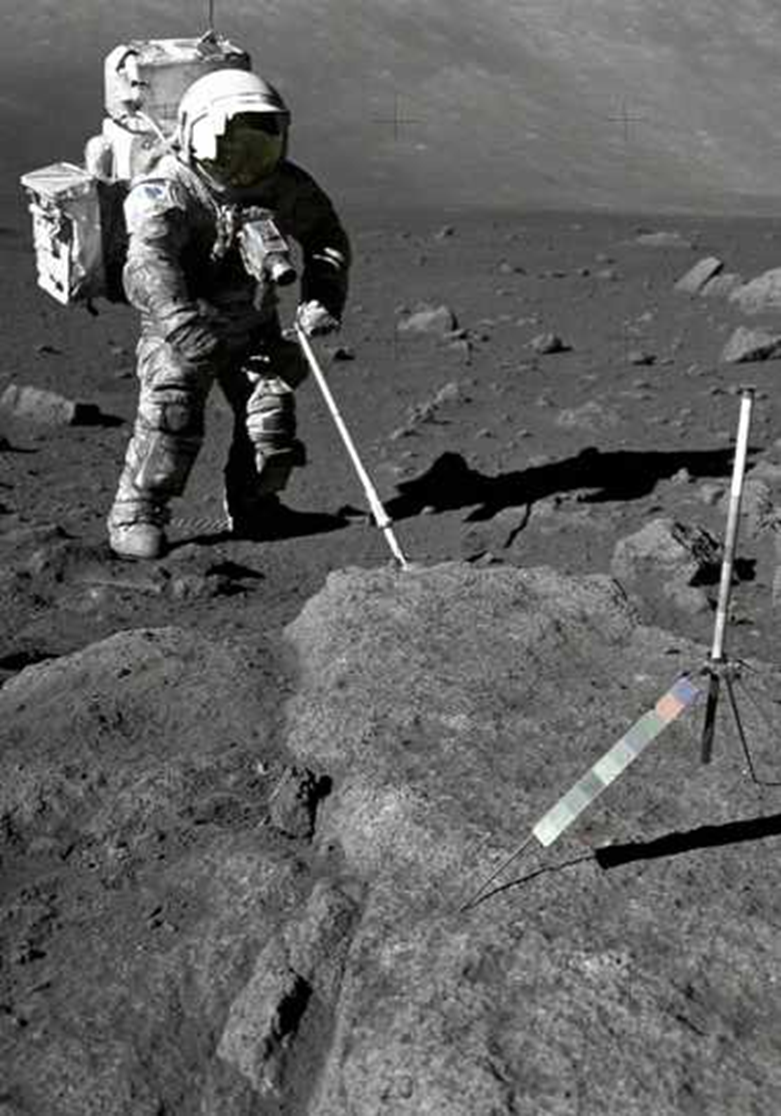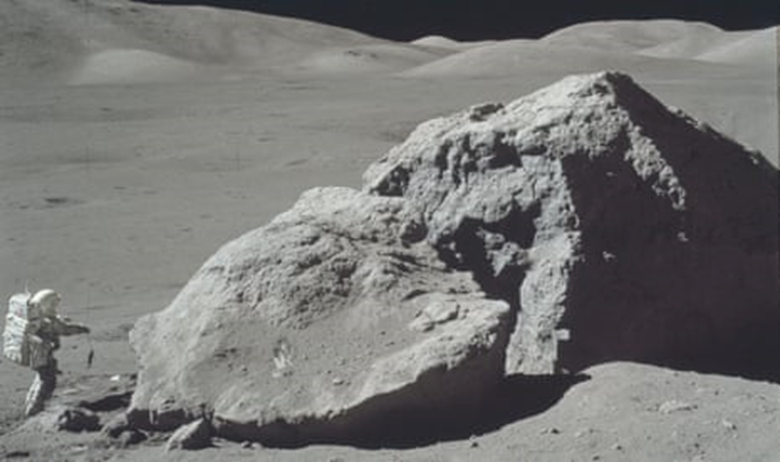Discovery: the Moon may be even older than we thought

The full moon is visible above the icebergs of Disko Bay, Greenland. Scientists studying lunar samples brought back as part of the Apollo program have discovered that the lunar crust formed at least 40 million years earlier than previous estimates suggested.
The Moon would actually be several million years older than previous estimates suggested.
Half a century has passed since humans first set foot on the Moon , and the samples they brought back from their journeys continue to reveal important information today. Indeed, after having been preserved for several decades in order to await the development of more sophisticated scientific instruments which would allow them to be studied more effectively, some of the rocks collected in 1972 were able to reveal that the Moon is in reality several millions older. years than previous estimates suggested.
By analyzing atomic clues trapped in a zircon crystal, one of the oldest minerals dating from the time the Moon was formed, scientists were able to determine that the latter was at least 4.46 billion years old. 'years. This age, revealed this week in an article published in the journal Geochemical Perspectives Letters , advances previously proposed estimates by 40 million years and thus brings the birth of our satellite considerably closer to that of the solar system , estimated at 4.57 billion years. 'years .
Determining the age of the Moon could help scientists trace the sequence of events that occurred in its earliest days. “Timing is everything,” says first author Jennika Greer, a cosmochemist at the University of Glasgow who worked on the project when she was a student at the University of Chicago. “Our solar system has been around for some time, but many very dynamic processes have occurred over its first few million years. »

The zircon crystal used to determine the age of the Moon was collected in a sample during the Apollo 17 mission in December 1972. Astronaut and geologist Harrison Schmitt is here covered in lunar dust during the mission.
In the early days of the solar system, the Earth did not have a moon, and therefore orbited the Sun alone. Its first days were, however, far from peaceful: according to scientists, at the beginning of our planet's history, an object the size of Mars would have struck the proto-Earth , thus causing a total upheaval of the two worlds.
The intense heat of the impact liquefied the two bodies, causing them to merge into a single celestial object. From this new mass escaped a small ball of molten rock which placed itself in a stable orbit around the Earth, eventually cooled, and became our Moon.

Scanning electron microscope view of a lunar zircon grain.
Once solidified, the Moon's internal structure took the form of a differentiated body composed of layers of mantle and crust. The molten rock gave rise to the crystallization of new minerals, including zircon, which was one of the last to form. These crystals are the physical witnesses of the last phases of the solidification of the Moon, and thus mark the beginning of the history of the natural satellite that we know today.
COUNT ATOMS
Because of its robustness, zircon is the preferred mineral of scientists; micrometric in size, its crystals can resist billions of years of alteration and preserve the geochemical secrets of their own birth. Additionally, zircon crystals capture uranium isotopes present in the environment when they were formed, a phenomenon that experts can use to their advantage to determine how long ago the crystallization process took place.
Because uranium isotopes decay into lead at a predictable rate, researchers can calculate how long it has been since zircon went from liquid to its current solid state by counting the number of lead atoms which were formed as well as the number of uranium atoms remaining.

The authors of the study analyzed the zircons contained in a sample of lunar rock taken during the Apollo 17 mission in 1972, and created a 3D map of the atoms they contained. After counting lead isotopes, scientists concluded that the zircon was 4.46 billion years old, making it the oldest estimated age of lunar crust formation to date.
This age had already been determined in 2021 by Greer's collaborators, led by Bidong Zhang and Audrey Bouvier , a work which had, however, been met with some skepticism. According to critics of the time, lead atoms tend to migrate in the rock and, as a result, form pockets in which lead concentrations could be more or less high. With this in mind, it would therefore be possible, depending on the sample analyzed, to analyze pieces of rock in which the lead would be unevenly distributed, and thus, to incorrectly calculate the age of the zircon.
To allay these concerns, Bouvier contacted Greer's team and asked them to count the atoms again, this time with an ion probe capable of sampling the rock with much higher spatial resolution than the one she had used in his own study. This more precise equipment was supposed to allow the team to determine whether certain nanoscale regions of the samples contained unequal amounts of lead atoms. Scientists found no difference.

“Everything was homogeneous in this zircon. So we didn't have to worry about it,” reveals Philipp Heck, study author and cosmochemist at the Field Museum and the University of Chicago. The result confirmed that the previously measured age of 4.46 billion years was indeed accurate.
“It's a very, very good study,” says Melanie Barboni, a geochemist at Arizona State University who was not involved in the new research. For his part, Barboni studied other isotopes in lunar zircons, which had already made it possible to discover that the distinct layers that make up the interior of the Moon had formed 4.51 billion years ago . before the final phases of lunar crust formation described in the new study.
According to the geochemist, this new research is compatible with her own conclusions. “Many papers suggest that the Moon formed much later, 4.3 billion years ago, for example,” she adds. “It is clear that, given this data, this is not possible. »

THE LINKED DESTINIES OF THE EARTH AND THE MOON
Determining when our satellite solidified gives future researchers a reference point to model its evolution. “The timeline helps us put everything in context,” says Greer. “We can then begin to understand the processes taking place. » Identifying the events that took place during the Moon's formative years and their timeline could help explain its current appearance.
The real interest in studying the Moon, however, is more linked to what it can teach us not about itself, but about our own planet. Due to their common origin, the destinies of the Earth and the Moon are in fact linked; However, Earth, which is geologically active, tends to bury and destroy evidence of past events over time, making it difficult to study its history. For its part, the Moon is much more transparent: thanks to the absence of tectonic activity, the geological traces that decorate its surface are much better preserved, and for much longer.
Scientists can examine evidence collected on the Moon to infer what may have happened on Earth around the same time. For example, during the collision that created the Moon, Earth became uninhabitable (nothing could have survived such a catastrophic event), and it is likely that all of its water boiled and evaporated, explains Rig. If this was indeed the case, another subsequent event, such as new asteroid impacts, must have brought water back to our blue planet, which would also have left traces on the Moon.

Although the new study estimates the end of the Moon's formation at 4.46 billion years at the latest, the entire process, from planetary collision to its final solidification, took place over several millennia . The zircon extracts constitute the last vestiges of the lunar magma ocean, and thus represent the end of the first violent chapter of the Moon and the beginning of its new, calmer era.
Heck and Barboni would not be surprised if future researchers found traces of older zircons that would put an even higher age on the Moon. NASA's lunar reserves could, for example, contain an older crystal, although these are rare according to Heck. It is also possible that other crystals are waiting to be discovered in regions of the Moon where we have not yet set foot.
Several missions intended to analyze new lunar regions are planned. In 2024, China will launch a robotic mission that is expected to bring back samples from the far side of the Moon , and NASA's Artemis III mission aims to land humans on the lunar south pole in December 2025. Rocks collected from these new sites could help clarify the history of the origins of the Moon.
Source : websites

